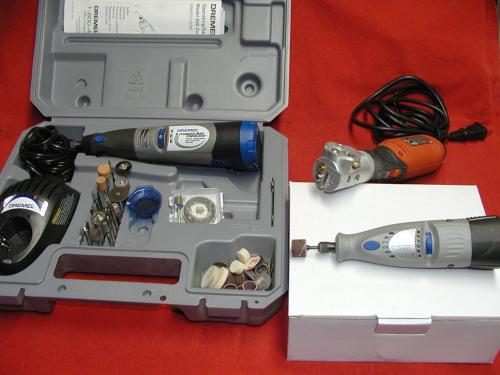Posts: 4,683
Threads: 93
Joined: Feb 2012
Location: Perth, Australia
The following 1 user Likes Mayhem's post:
EdK (05-15-2014)
Willie, here you can buy 'kit' form electric motor speed controllers, primarily sold for electric drills. I'm sure you have them there and I'm pretty sure off the shelf built ones are not that expensive. Bypass the pot on the Dremel (or leave it on 7) and plug it in and enjoy speed control once more.
Hunting American dentists since 2015.
Posts: 4,493
Threads: 187
Joined: Feb 2012
Location: Missouri, USA
05-15-2014, 09:31 AM
(This post was last modified: 05-15-2014, 01:10 PM by Highpower.)
That is a good idea Darrin but I'm not worried about it. It still has
some control over the speed at the high end, it's just real touchy. It was worth replacing the bearings just to have it working again, but I didn't really
need it. I just hate throwing away tools....

Other than that I still have 2 other cordless Dremel tools, the Craftsman flex-shaft tool and the new Foredom tool I just got. 5 total. Well... 4 total actually. The wife stole the smallest 2-speed cordless for herself. But I'll let that slide since she and the daughter got me the Foredom for my birthday.


 Correction:
Correction:
No, I guess it's 5 of them after all. It must be a disease ...

I forgot about my "Sharpie" tungsten grinder.


Willie
Posts: 125
Threads: 18
Joined: May 2014
Location: IN
(05-14-2014, 10:20 PM)Highpower Wrote: Got the new bearings in the mail today. These have no markings on them anywhere. But they are the correct size so that's what counts.
Installed the rear bearing on the armature shaft, making sure that it was in the same spot as the old bearing. 7/64" from the square edge of the shaft. The shaft end is rounded. (I measured it before removing the old bearing.)
Then installed the front bearing in the end bell, put in the retaining ring and crimped it back into place. You have to carefully tap around the inside lip of the end bell (red arrows) to open it up in order to remove the original bearing.
Piece the motor back together and insert it and the speed controller back into the case halves. Re-install the brushes and it's done.
Final results: Mixed.
The good news - the motor runs quiet again (well, for a Dremel) with no screeching noise, and the nose of the tool stays cool. It would heat up quickly with the bad bearing and become uncomfortable to hold.
The bad news - I didn't fix my speed control issue. It lost most of it's variable speed right before the bearing went bad. While I had it apart I flushed out the rheostat(?) / potentiometer(?) with some contact cleaner (DeOxit-5) in hopes that it would revive the mid range of the speed control. But no luck on that front. The speed dial is marked 1-7 and from 1 to about 5-1/2 the tool only runs at slow speed. From there it ramps up quickly to full speed at "7". It's not a linear increase in speed over the entire dial.
In the end, it's basically a one speed tool now, but at least it's usable again. It will make a good "loaner". 
Highpower would you be so kind as to give me the name and model # of the indicator holder you are using. Thanks
tackit, proud to be a member of MetalworkingFun Forum since May 2014.
Posts: 8,888
Threads: 320
Joined: Feb 2012
Location: Arizona/Minnesota
It looks like a genuine Noga to me.

Ed
Posts: 4,493
Threads: 187
Joined: Feb 2012
Location: Missouri, USA
Indeed. That one is a Noga DG61003.
Lots of choices available from Noga though. Different sizes / strengths of magnetic bases, (or none at all) different lengths of arms, top or bottom fine adjustments, (or none at all) indicator holder type, etc., etc.
It's like ordering a burger at Burger King. "You can have it your way."

Willie









